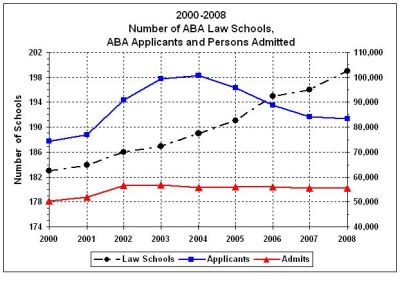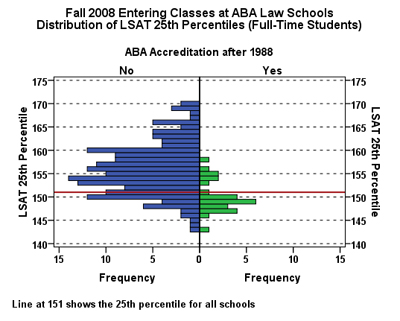In Do We Need More Law Schools, I commented on the number of new law schools that have been in the works. In that post, I used the number of JDs granted per year, largely as a matter of convenience. But what about the demand for law school itself–the number of persons interested in going to law school. Several commenters suggested that the proper measure is the demand for lawyers, especially by firms that employ lawyers. While employment opportunities, and starting salaries, are a major factor affecting the demand for legal education, it is not the sole factor. Whatever the underlying causes, the demand for legal education says something about the need for more law schools (as opposed to more lawyers).

The above chart uses information drawn from the current (as of October 2, 2009) LSAC Volume Summary (under the “Data” section). For the Fall 2000 entering classes, 74,600 persons applied, of which 50,300 (67%) were admitted. For Fall 2008, 83,400 persons applied, of which 55,300 (67%) were admitted. From Fall 2000 through Fall 2004, the number of applicants increased to 100,600, of which 55,900 (56%) were admitted. From Fall 2004 through Fall 2008, the number of applicants fell by 17,200 persons (17%), but the number of persons admitted fell by 400 (less than one percent). During that same period, the number of law schools increased by 9%, from 183 to 199.
But compare that with the number of applicants for Fall 1991 through Fall 1995 (estimated by combining data from the applications per applicant chart in the LSAC report, National Applicant Trends–2008, with Table 1 in Charles Longley, Law School Admissions, 1985 to 1995, Assessing the Effect of Application Volume (1998) (LSAC Research Report Series, No. RR-97-02)). The estimated number of ABA applicants to fell from a high of 86,700 for Fall 1992 (176 schools) to 72,800 for Fall 1995 (179 schools). Thus, since 1992, the number of applicants has fallen, risen, and fallen again, for a net loss of 3,300 persons (almost 4%), while the number of ABA law schools has increased by 22 schools (over 12%).
Because Longley focused on ABA applications and admissions, rather than persons admitted, I do no not have the numbers of the number of persons admitted. As shown in the ABA’s table, Enrollment, and Degrees Awarded, first-year enrollments have seen some dips since Fall 1991 (44,050), but have increased to 49,414 in Fall 2008 (an increase of 12%). That tracks the JDs awarded by ABA law schools (see the chart in Do We Need More Law Schools?).
So we have more law schools chasing the same number of applicants, but enrolling more students. I don’t think the increased competition has hurt the elite law schools. That means that the rest the law schools, particular those in U.S. News Tier 4, have more competition for students, and will have to dip deeper into the applicant pool. For a law school, lower academic credentials tend to translate into lower Bar passage rates, especially in high cut-score states, such as California.
So, if you concluded from my earlier post that, as a professor at a Tier 4 school, I must be in favor of more law schools, you were wrong. Apparently, the numbers do not speak for themselves, so let me be clear:
Flat Demand + More Law Schools = Trouble
That said, since Fall 2003, law schools have held the number of admitted applicants relatively flat, and even cut the numbers somewhat. Yet enrollments have still gone up. That’s because more of the admitted applicants are choosing to go to law school. For Fall 2003, 48,900 out of 56,800 admitted persons (86%) actually enrolled, while, for Fall 2008, 49,414 out of 55,500 (89%) enrolled (LSAC Volume Summary).
Gary Rosin


GPAs and Standardized Test Abuse
Friday, October 23rd, 2009An article by Scott Jaschik, More Testing, Less Logic? (Inside Higher Ed) comments on an article by Anne VanderMey, GMAT: The MBA Job Seeker’s Best Friend (Business Week). VanderMey reports on a disturbing trend in the MBA job market:
According to both VanderMey and Jaschik, some schools are advising students to retake the GMAT.
VanderMey observes that while employers looking for people to do “heavy quantitative lifting” find the quantitative portion of the GMAT useful, the real problem is that GPAs are not always useful:
The problem with GPAs is that they are not objective measures of performance. Rather, they just sort each cohort of admitted students. The strength B-school cohorts vary from school to school, and even from year to year.
Jaschik suggests that the problem is more acute at lower-ranked B-schools:
Jaschik’s main focus is on the use of GMAT scores for purposes other than as a guide to first-year MBA grades. He argues that testing companies, such as the GMAC (presumably, the Graduate Management Admissions Council), should more actively resist the use of test scores for purposes other than admission.
U.S. News uses LSAT scores of entering classes as one of the factors in its rankings of law schools. The LSAC and the ABA also report the LSAT profiles of entering classes in their annual Office Guide to ABA-Approved Law Schools. Of course, they also provide a wealth of additional data about each law school.
Has anyone heard of law firms and other employers of lawyers using LSAT scores in evaluating job applicants?
posted by Gary Rosin
Posted in Commentary, Law Schools, LSAT, Rankings | No Comments »